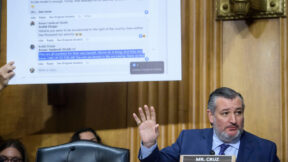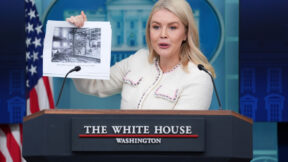Trump Falsely Claims He Released ‘Exact Transcription’ of Ukraine Phone Call Amid Impeachment Inquiry
President Donald Trump falsely claimed that the transcript of his phone call with Ukrainian President Volodymyr Zelinsky he released was an “exact transcription,” despite the very clear disclaimer that sits at the top of the so-called transcription.
The comments came during a brief press spray on the tarmac at Joint Base Andrews where President Trump was initially asked about not sharing information about the death of ISIS leader Abu Bakr al-Baghdad. An unidentified reporter asked if he was “concerned Nancy Pelosi and others can’t be trusted with this kind of information?”
Trump quickly pivoted to Rep. Adam Schiff saying “Well I guess the only thing is, they were talking about why didn’t I give the information to Adam Schiff and his committee? The answer is because I think Adam Schiff is the biggest leaker in Washington. You know that. I know that we all know that. I watched Adam Schiff leak. He is a corrupt politician.”
He later simplified the story that lays at the heart of the impeachment inquiry that is looking into the alleged quid pro quo of the White House withholding Congressionally approved aid to Ukraine in return for a public investigation into his political rival Joe Biden and his son Hunter.
Trump had what has been called a “transcript” of that call released, which he referred to as an “exact transcription.” Trump said, “they tried to take that conversation and make it into a big scandal.” He then said “it was an exact transcription of the conversation. In a nutshell, a whistleblower wrote a false narrative of the conversation.”
But that’s not the case. As is clearly described in the CAUTION at top of the memo:
CAUTION: A Memorandum of a Telephone Conversation (TELCON) is not a verbatim transcript of a discussion. The text in this document records the notes and recollections of Situation Room Duty officers and NSC policy staff assigned to listen and memorialize the conversation in written form as the conversation takes place. A number of factors can affect the accuracy of the record, including poor telecommunications connections and variations in accent and/or interpretation, The word “inaudible” is used to indicate portions of a conversation that the notetaker was unable to hear.
How different is the released “transcript” from the actual discussion on the phone call? We may never know. But the description of “exact transcription” does not align with the “not a verbatim transcript of a discussion” disclaimer.
Watch above via Fox News.




